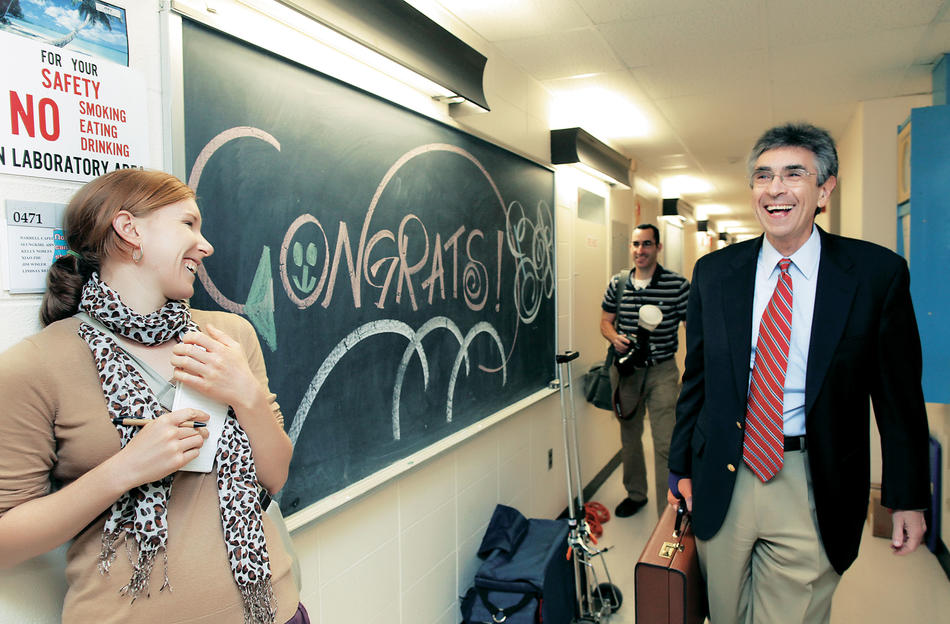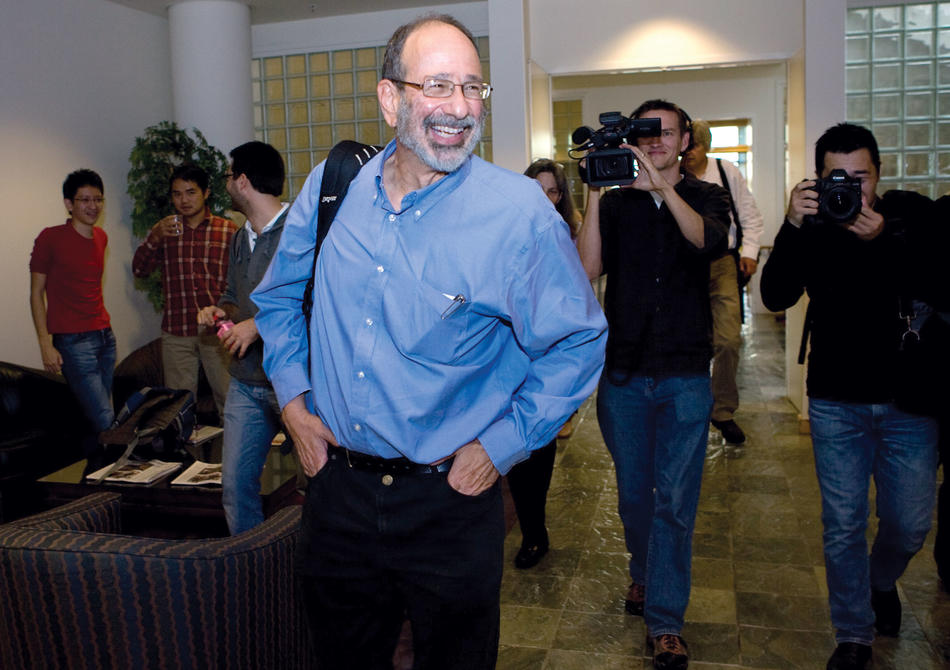Among the nine intellectuals who traveled to Stockholm to receive Nobel Prizes on December 10 were two Columbians: Robert J. Lefkowitz ’62CC, ’66PS and Alvin E. Roth ’71SEAS.
Lefkowitz, a professor at Duke University Medical Center, was awarded the prize in chemistry jointly with Stanford’s Brian K. Kobilka for describing how tiny receptors in cell membranes can detect chemicals on the outside of a cell and then translate that information into useful instructions on the inside. The insight is now a cornerstone of drug research.
“Bob Lefkowitz changed our knowledge of one of the most important pathways of the human body,” said Robert S. Kass, a Columbia pharmacology professor, shortly after the prize was announced in October.
Alvin E. Roth, a longtime Harvard professor who was recently recruited away to Stanford, shares the prize in economics with Lloyd S. Shapley, a retired UCLA professor. They were honored for developing new ways to distribute goods or services in situations where no money is exchanged, such as in assigning children to popular public schools or in allocating donated organs to people who await transplants.
“The combination of Shapley’s basic theory and Roth’s empirical investigations, experiments, and practical design has generated a flourishing field of research and improved the performance of many markets,” reads a statement from the Nobel Foundation. “This year’s prize is awarded for an outstanding example of economic engineering.”
Lefkowitz and Roth are each sharing a $1.2 million prize with their co-winner.
Cells and sensibility
Robert Lefkowitz was a research fellow at the National Institutes of Health in the late 1960s when he took up a problem that had baffled scientists for decades: how the billions of individual cells in our bodies detect what is happening outside the confines of their own cell membranes. Scientists had long suspected that these membranes must contain receptors; this had seemed apparent since the late nineteenth century, when scientists first observed that cells respond to the presence of hormones like adrenaline without allowing those hormones to permeate them. But scientists had failed to spot any such receptors.
“When I started doing my work, there was still some skepticism as to whether receptors really existed,” says Lefkowitz, a Bronx native who graduated at the top of his class at Columbia’s College of Physicians and Surgeons in 1966.
Lefkowitz hypothesized that the receptors were simply too small to have yet been seen and he searched for them using a novel experimental approach: he attached radioactive iodine to hormone molecules, which enabled him to monitor each molecule’s path. If a molecule attached itself to a cell membrane, he would bring all his analytic firepower to bear on that spot.
Over the next few years, Lefkowitz and his research team achieved a series of breakthroughs that virtually defined the nascent field of receptor biology. They showed, for instance, that a typical cell receptor consists of an extremely long amino-acid chain wrapped up like a bundle of rope; that the receptor is embedded in a cell membrane like a plug, with one end protruding from the membrane and the other anchored to its inner surface; and that when the exposed end of the receptor is stimulated by a molecule, the shape of the entire receptor changes in a way that triggers a cascade of metabolic activity inside the cell.
Many of Lefkowitz’s discoveries were made while he was working closely with his fellow Nobel recipient Brian K. Kobilka, who was a postdoctoral researcher in Lefkowitz’s laboratory in the 1980s. Together, they identified genes that contain the DNA blueprints for several cell receptors, each being sensitive to a specific hormone, neurotransmitter, or growth factor. This gave them clues about the structure and function of the receptors.
It was for their role in characterizing “G protein–coupled receptors,” the largest class of cell receptors in the human body, that Lefkowitz and Kobilka received the Nobel. Their research led to the discovery of more than a thousand receptors and ushered in a new era of drug development. Today, nearly half of all drugs target G protein-coupled receptors.
Lefkowitz, who serves on the College of Physicians and Surgeons board of visitors, reflected on his student days here while speaking at an alumni event in 2011. As a medical student, Lefkowitz said, he never considered a career in research: “To me, medicine was like a priesthood. I always thought it was the highest and noblest thing you could do in life.”
And although he would soon become “addicted to data” and convinced that advancing medical knowledge was his calling, Lefkowitz still feels that “being a physician is the greatest thing in the world,” he said. “When I write down my occupation, I still write down ‘physician.’”
Better matchmaking
For parents in most US cities, getting a child into a good public school requires careful strategizing. That’s because districts use a school-assignment system whose results can be manipulated. Here’s how it works: parents are asked to submit an ordered list of their preferences. Every school then accepts or rejects those students who listed the school as their first choice. Children who get rejected by their top-choice school are considered by their backup schools only after those schools have looked at all of the children who picked them as a first choice. The result is that parents with unrealistic expectations about a child’s chances of getting into a popular school may get the child bumped all the way down to one of their district’s least desirable schools, as even the ones in between fill up. Meanwhile, an unexceptional student may secure a spot in a highly-rated school if the parent picks, say, the district’s third- or fourth-best school as a top choice.
Is there a better way?
Alvin E. Roth has devoted his career to solving such problems. An economist who studied operations research at Columbia’s engineering school, he is an expert in an area of macroeconomic research called matching theory, which addresses how central planners can distribute resources efficiently and fairly. His work builds upon mathematical principles developed in the 1950s and 1960s by Lloyd S. Shapley, with whom Roth shares the Nobel. Shapley’s research, while groundbreaking, was abstract and often whimsical: his most influential paper describes how a group of men and women can schedule dates among themselves in a way that speedily pairs each person with someone they can be assured is the most attractive person who will have them. Roth’s achievement has been to find more pressing real-world problems to which Shapley’s algorithms can be applied.
In the case of school selection, Roth has developed computer programs that help education officials make assignments in a way that balances family preferences with the academic requirements of individual schools, all while creating an incentive for parents to be truthful in their applications. In 2003, New York City implemented a version of Roth’s system, which has since increased the percentage of parents who say they are pleased with their child’s assignment. Boston, Chicago, and Denver have also adopted Roth’s system.
More recently, Roth developed software that physicians across the US are using to organize kidney-donor exchanges. The exchanges address a common problem: when a person needs a kidney transplant, a relative may come forward to donate one, only to find that he or she is an unsuitable donor. Doctors, in response, have begun organizing large networks of people such that every participant who needs a kidney receives one from a compatible stranger. Roth’s software identifies which pairs of relatives should be in a given network so that people receive organs best suited to their bodies.
“He’s helping to transform modern medicine,” says surgeon Michael Rees, who runs the transplant center at the University of Toledo Medical Center.
According to Roth, using powerful mathematics to improve people’s lives is the essence of economics. “Some say economics has all kinds of good tools and techniques, but it has an absence of interesting problems,” he told Forbes magazine in 2010. “I look around the world, and I see all kinds of interesting, important problems we ought to solve with the tools we have.”




